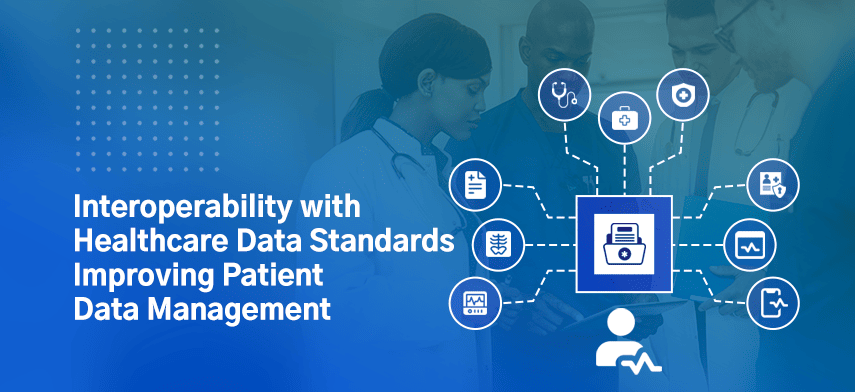Allowing the impeccable exchange of healthcare data and information amongst the systems and applications is crucial in understanding the complete benefits of electronic health information. Before the application of healthcare data standards, the information remained trapped in the proprietary systems of healthcare organizations and facilities. With growing technological advances, providers, patients, and payers are omitting the traditional paper-based sharing of health data and information.

Hospitals and health systems have an ever-growing requirement for a multitude of connected systems. One of the healthcare data standards, namely, the HL7 V2 was widely integrated worldwide as a data exchange standard enabling the healthcare information system with communication required clinically. This was possible due to the integrated nature of HL7 assisting multiple channels for data interchange. The HL7 standard has also allowed communication between administrative data systems.
Let’s dive deeper into understanding the requirement for HL7 and FHIR healthcare data standards.
Understanding HL7 V2 Implementation
As mentioned earlier, HL7 v2, launched in the year 1989, became the most widely integrated healthcare data standard around the world. Even today, 95% of the US healthcare organizations and facilities use this version of the data exchange standard for sharing information across multiple channels. The HL7 V3 was launched to address the shortcomings of HL7 v2. Being of non-backward compatible standard, only a handful of organizations implemented the V3 version of the upgrade.
HL7 v2 operates by offering communication language to distinct healthcare systems like the electronic medical record or EMRs, radiology and picture archiving systems, hospital information systems, billing systems, and more. This particular language of communication comprises ASCII text-based messages. The systems mentioned usually transmit the messages to each other when a patient is admitted to the hospital, when a provider bills the patient, placing a pharmacy order by doctors, and other such necessary events.
The HL7 v2 has assisted healthcare organizations to avoid complex situations due to the creation of distinct communicative systems. It has also helped to develop custom software work that is needed to build certain interfaces. This healthcare data standard requires definite precision and specification to rely on custom coding and utilize interface engines for achieving healthcare interoperability amidst the communication system.
Evolution of Health Data Management from HL7 Standard
The existence of data and information that is outside of the healthcare organization cannot be ignored in this day and age. The expectations of interoperability became adaptable to the nature of data that is required to be collected from pharmacies, laboratories, and payers. One of the major benefits of HL7 v2 integration is its ability for widespread adoption and adjustability globally. The longevity of this version of the HL7 standard is considered remarkable and it will still be used in the future for certain scenarios.
With health data management, the proper communication of data within medical organizations and between them was critical for offering enhanced patient care. Integrating the universal healthcare data exchange standards in data systems can achieve this standard. The evolution of health data management from HL7 standards is to enhance the level of patient care delivery via implementing the data communication system to provide relevant information.
The Requirement for Data Exchange Standards in Healthcare Industries
There are several variables when it comes to healthcare data management that is necessary for maintaining the descriptions and additional rules. There’s no space for ambiguity when the interpretation and transferring of patient information is involved. This information consists of the patient’s procedures, allergies, medication requirements, etc. The all-inclusive healthcare data standards bring the organizations a step closer to achieving streamlined and seamless interoperability. Without this data system, operating within the disparate data silos and having difficulty in accessing EHRs could be considered a downfall in the data exchange system in healthcare.
A few benefits for adopting healthcare data exchange standards include:
1 Integration of data across all healthcare systems
Maximum hospitals and health systems use electronic medical records (EMRs), radiology information systems (RIS), picture archiving and communication systems (PACS), and laboratory information systems (LIS). without having strict and defined healthcare data standards, moving the information across these channels can be difficult. Integrating healthcare data standards along with a proper and effective hospital management system can assist in ensuring error-free communication of data and reduce unnecessary delays.
2 Improved decision-making capabilities
For providers and medical health professionals, healthcare data standards have made the availability of essential data easier and more accessible. Thus, it has been crucial in improving decision-making capabilities in saving the lives of patients.
3 Ensures enhanced compliance and compatibility
The need to worry about inconsistencies regarding HL7 standards or FHIR standards being in their relevant spaces can curb gaps in compliance that concern the security and privacy of patients’ information. Healthcare data standards ensure maximum compatibility and compliance in providing that sense of data security.
4 Rapid medical billing and claims processing
Having standardized codes for medical procedures and terminologies can help to streamline the process of billing, leading to substantiating claims and providing fewer rates of rejection.
The points mentioned above clearly demonstrate the significance of healthcare data standardizations and the quality of data in healthcare. By strategically planning and implementing it, businesses can save the medical resources, in turn, achieving higher success rates in patient satisfaction and considerable growth of revenue generation.
Significance of FHIR Standard in Healthcare
We have witnessed the steady growth of smartphone ownership over the last decade. Even though the HL7 v2 was well known before the immense of the internet, the 3rd version tried to address the concerns of v2 but it wasn’t successful for implementation due to its complexities.
FHIR healthcare standard was drawn from the HL7 protocol and further combined with the existing web technology services, including the e-commerce platforms. This standard’s main focus was on creating a tool that can be easily implemented by software developers and vendors. Using the HL7 v2 standard as the base, Fast Healthcare Interoperability Resources or commonly known as FHIR, added technologies like XML and JSON for IT specialists. With flexibility in data defining, FHIR allows a comfortable transition from a document-based approach to sharing the data elements effortlessly. FHIR also can make use of advanced programming interfaces or APIs to develop customized interoperability solutions. This is one of the reasons behind the popularity of FHIR as it is intensely used in EHRs for the US healthcare industry.
So why has FHIR become this important in healthcare data standards? Let’s take a look at its benefits.
1 FHIR standards are present everywhere
With the popularity of the FHIR standard, software developers and EMR/EHR vendors are having higher engagement with FHIR interoperability regularly. This has resulted in acquiring in-depth expertise and in offering various available solutions to organizations and facilities. FHIR can help to find the product that suits best for an organization or help them build one from scratch.
2 FHIR is versatile and adaptable
The FHIR standard in healthcare data standardization ensures enhanced compatibility of APIs and offers a guarantee that applications based on them can be used simply in various situations. The APIs being reusable promotes the interoperability implementation of the data exchange standard. Hence, helping to save resources during the process of development.
3 The data exchange standard is future proof
FHIR has been developed keeping its flexibility and versatile nature in mind, and it reflects the changes according to the industrial requirements. FHIR is considered an excellent selection when upgrading a particular legacy system. It can easily absorb any new emerging data exchange standards and keeps all the data collected intact and secure.
4 It s open-source in nature
FHIR is a vibrant community for health IT experts, and it is more than just a set of rules that have been put in place. This healthcare data standard allows IT healthcare professionals to invest their effort and time to address any challenges that are noted in healthcare data exchange. FHIR being an open-source development model promotes creating free components in the FHIR ecosystem. Thus, it helps developers to create their solutions with cost and time-saving management.
5 HL7 FHIR standard is mature
FHIR has a solid background, unlike the other healthcare data standards. It is based on one of the most established data exchange standards in the healthcare field, HL7 v2. FHIR development has reached a space where it consists of a standalone set of precise specifications that helped in reaching a maturity to be utilized at a global scale.

Building an Interoperable Healthcare System in the Future
The interoperability in healthcare has managed to create significant strides since the onset of Health Information Technology for Economic and Clinical Health (HITECH) was passed. With the implementation of the 21st Century Cures Act, healthcare IT professionals are helping to provide a driver for better interoperability. With the exposure of gaps in healthcare during the pandemic, healthcare information sharing and interoperability has become a critical aspect for healthcare investors to implement in their systems. Organizations need to consider the privacy and security risks with the improvement in data interoperability in healthcare especially when patients need to navigate digital touchpoints and multiple applications.
The balance in interoperability and privacy is important, there are various challenges when interoperability and privacy are tempered, but it is necessary for enhanced healthcare data exchange operations. With the healthcare sector moving from a fee-for-service to a value-based care approach, the transition and ability to leverage the necessary data and churn out the information will become a key competing differentiator. Ensuring interoperability with FHIR standards maneuvers success for healthcare systems.
Final thoughts,
It’s time to take action and instead of contemplating whether healthcare data standards need to be implemented or not. The changes that occur within healthcare data communication are inalterable. The popularity of mobile applications and the accessibility requirements for patient information from any communication system is pushing the healthcare industry forward. With Digitech companies like Mobisoft, companies, and organizations in the healthcare sector can easily implement such healthcare data standards, for better data exchange management. The future of healthcare relies heavily on the seamless flow of data communication systems across hospitals and healthcare organizations. Whether your requirements are for legacy systems or the need to build a custom solution for your management, Mobisoft can help to create.

Author's Bio

Shailendra Sinhasane (Shail) is the co-founder and CEO of Mobisoft Infotech. He has been focused on cloud solutions, mobile strategy, cross-platform development, IoT innovations and advising healthcare startups in building scalable products.


